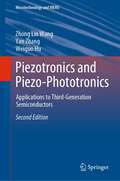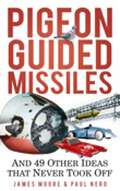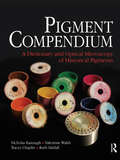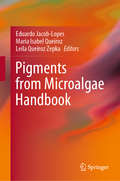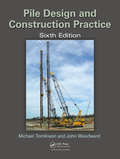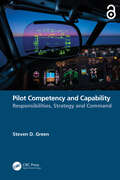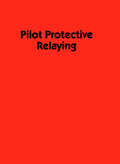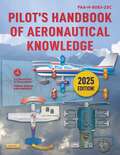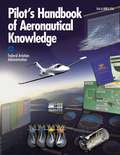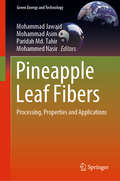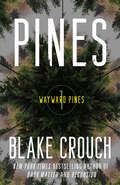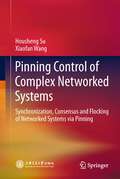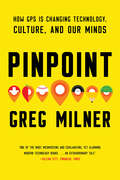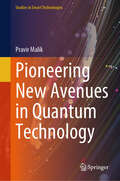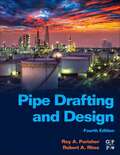- Table View
- List View
Piezotronics and Piezo-Phototronics: Applications to Third-Generation Semiconductors (Microtechnology and MEMS)
by Zhong Lin Wang Yan Zhang Weiguo HuCo-authored by the discoverer of the piezotronic effect, this book is a fundamental and comprehensive survey of piezotronics and piezo-phototronics. Piezotronics is a term broadly applied to devices fabricated using the piezopotential as a “gate” voltage to tune/control charge carrier transport at a contact or junction. The piezo-phototronic effect describes the use of the piezopotential to control the carrier generation, transport, separation and/or recombination for improving the performance of optoelectronic devices. The book first introduces the theory of the piezotronic effect and its applications in transistors, sensors, and catalysis. Subsequent chapters comprehensively cover the fundamentals of the piezo-phototronic effect and its impacts on photon sensors, solar cells, and LEDs.The updated and significantly expanded second edition covers the most recent advances and breakthroughs in this field over the last decade — gas, chemical, and biological nanosensors; quantum dots, wells, and wires; piezocatalysis; the piezo-photonic effect; and the pyro-phototronic effect. This seminal book serves as a basic text for scientists and students in the field of piezotronic devices and third-generation semiconductors.
Pig Tales: An Omnivore's Quest for Sustainable Meat
by Barry EstabrookAn eye-opening investigation of the commercial pork industry and an inspiring alternative to the way pigs are raised and consumed in America. Barry Estabrook, author of the New York Times bestseller Tomatoland and a writer of "great skill and compassion" (Eric Schlosser), now explores the dark side of the American pork industry. Drawing on his personal experiences raising pigs as well as his sharp investigative instincts, Estabrook covers the range of the human-porcine experience. He embarks on nocturnal feral pig hunts in Texas. He visits farmers who raise animals in vast confinement barns for Smithfield and Tyson, two of the country's biggest pork producers. And he describes the threat of infectious disease and the possible contamination of our food supply. Through these stories shines Estabrook's abiding love for these remarkable creatures. Pigs are social, self-aware, and playful, not to mention smart enough to master the typical house dog commands of "sit, stay, come" twice as fast as your average pooch. With the cognitive abilities of at least three-year-olds, they can even learn to operate a modified computer. Unfortunately for the pigs, they're also delicious to eat. Estabrook shows how these creatures are all too often subjected to lives of suffering in confinement and squalor, sustained on a drug-laced diet just long enough to reach slaughter weight, then killed on mechanized disassembly lines. But it doesn't have to be this way. Pig Tales presents a lively portrait of those farmers who are taking an alternative approach, like one Danish producer that has a far more eco-friendly and humane system of pork production, and new, small family farms with free-range heritage pigs raised on antibiotic-free diets. It is possible to raise pigs responsibly and respectfully in a way that is good for producers, consumers, and some of the top chefs in America. Provocative, witty, and deeply informed, Pig Tales is bound to spark conversation at dinner tables across America.
Pigeon Guided Missiles: And 49 Other Ideas that Never Took Off
by James Moore Paul NeroDuring the Second World War, an American behavioural psychologist working with pigeons discovered that the birds could be trained to recognise an object and to peck at an image of it; when loaded into the nose-cone of a missile, these pecks could be translated into adjustments to the guidance fins, steering the projectile to its target.Pigeon-Guided Missiles reveals this and other fascinating tales of daring plans from history destined to change the world we live in, yet which ended in failure, or even disaster. Some became the victims of the eccentric figures behind them, others succumbed to financial and political misfortune, and a few were just too far ahead of their time. Discover why the great groundnut scheme cost British taxpayers £49 million, why the bid to build Minerva, a whole new country in the Pacific Ocean, sank, and why the first Channel Tunnel (started in 1881, over a century before the one we know today) hit a dead end.
Pigment Compendium: Optical Microscopy Of Historical Pigments
by Nicholas Eastaugh Valentine Walsh Tracey Chaplin Ruth SiddallThis is an essential purchase for all painting conservators and conservation scientists dealing with paintings and painted objects. It provides the first definitive manual dedicated to optical microscopy of historical pigments. Illustrated throughout with full colour images reproduced to the highest possible quality, this book is based on years of painstaking research into the visual and optical properties of pigments. Now combined with the Pigment Dictionary, the most thorough reference to pigment names and synonyms avaiable, the Pigment Compendium is a major addition to the study and understanding of historic pigments.
Pigments from Microalgae Handbook
by Eduardo Jacob-Lopes Leila Queiroz Zepka Maria Isabel QueirozThe Pigments from Microalgae Handbook presents the current state of knowledge on pigment production using microalgae-based processes, and covers both the scientific fundamentals of this technology and its practical applications. It addresses biology, chemistry, biochemistry, analysis and engineering aspects, as well as applications of natural pigments in photosynthetic organisms. The book also describes the analytical procedures associated with the characterization of pigments and the engineering aspects of microalgal pigment production. It considers the three major classes of pigments(chlorophylls, carotenoids and phycobiliproteins) produced and surveys the main commercial applications of these chemicals.The book offers a valuable source of information for industrial researchers and practitioners in industrial biotechnology, as it covers various engineering aspects of microalgal pigment production, such as bioreactors and bioprocesses, industrial extraction processes, and the bioeconomy of production including life-cycle assessment. The book will also be of interest to undergraduate and graduate students of biochemistry, food chemistry, and industrial microbiology.
Pigments, Extenders, and Particles in Surface Coatings and Plastics: Fundamentals and Applications to Coatings, Plastics and Paper Laminate Formulation
by Michael Diebold Steven De Backer Philipp M. Niedenzu Brett R. Hester Frank A. VanheckeThis book discusses the diverse array of particles that are found in coatings from both a physical and a performance standpoint. It also describes the fundamentals of particle behavior and shows how these affect the performance and properties of their end-use applications. It consists of nineteen chapters, demonstrating the wide range of types of particles found in coatings as well as the diversity of the important attributes they hold. The authors also present a forward looking view of current issues and trends in the coatings industry. In addition, a chapter on the use of particles in paper laminate, a closely aligned field, is included. This book is of interest to formulators of any type of coatings as well as researchers in aligned fields that use high volumes of small particles, such as the plastics and paper industries.
Pile Design and Construction Practice
by John Woodward Michael TomlinsonWritten to Eurocode 7 and the UK National AnnexUpdated to reflect the current usage of Eurocode 7, along with relevant parts of the British Standards, Pile Design and Construction Practice, Sixth Edition maintains the empirical correlations of the original-combining practical know how with scientific knowledge-and emphasizing relevant principles an
Pile Foundations for Buildings and Structures in Collapsible Soils
by A.A. GrigorianA translation of a Russian study on pile foundation in collapsible soils, revised and updated for the 1995 English edition. The contents cover such topics as collapsible soils as basis for structures, and designing pile foundations for buildings and structures with collapsible soils.
Piles in Hydrotechnical Engineering
by V.G. Fedorovsky Yu. M Kolesnikov S.V. Kurillo S.N. LevachevThis work describes studies of pile footings widely applied in hydrotechnical engineering. Generic piles design techniques are discussed and the coupled load analysis of piles subject to vertical, lateral forces and moments, as well as the input data, are defined.
Piling Engineering
by Ken Fleming Mark Randolph Austin Weltman Keith ElsonPiling is a fast-moving field and recent years have seen major advances in theory, methods, testing procedures and equipment. Some of these changes have been driven by the need for economies and efficiency, reduced spoil production and new methods of pile bore support. Advances in theoretical analyses allow pile design to be refined so that piles and pile groups perform to better advantage.This third edition of the well established book has been comprehensively updated. It provides an accessible and well-illustrated account of design techniques, methods of testing and analysis of piles, with a marked emphasis on practice but with design methods that incorporate the most recent advances in piling theory.Piling Engineering is written for geotechnical engineers, consultants and foundation contractors. It is also a useful reference for academics and advanced students on courses in piling, practical site investigation and foundation design and construction.
Pilot Competency and Capability: Responsibilities, Strategy, and Command
by Steven D. GreenPilot Competency and Capability presents strategies for the air carrier pilot-in-command operating complex engineered systems within a complex natural environment. It bridges the gap between academic books and practical application by providing real-world examples of how various safety and operational theories work in practice. The book advises on how to develop concepts, strategies, and ways of thinking that integrate with existing structures and FAA regulations, while understanding how engineered systems and codified structures interface with complex natural environments. It considers how the prescribed safety margins function to manage emergent behaviors of both the natural environment and the engineered systems. The book is intended for airline pilots, training captains, simulator instructors, and aviation students taking courses in aviation safety, risk management, and flight safety to improve in-flight decision-making, risk analysis, and strategic planning.
Pilot Protective Relaying (Electrical Engineering and Electronics #109)
by ElmoreThis text concentrates on the fundamentals of protective relaying and aims to provide lasting information in intelligible language. It covers the relative qualities of modern transmission line systems, communications channels, three-terminal applications and program design for microprocessors, and also supplies an encyclopaedic bibliography listing professional papers useful to the relay engineer.
Pilot's Handbook of Aeronautical Knowledge: FAA-H-8083-25C (ASA FAA Handbook Series)
by Federal Aviation AdministrationTHE ESSENTIAL FULL-COLOR HANDBOOK FOR PILOTS, IN A NEW 2023 EDITION! This official Federal Aviation Administration (FAA) handbook provides basic knowledge essential for pilots on topics like decision-making, aerodynamics, flight controls, weather theory, airport operations, and more. Pilot's Handbook of Aeronautical Knowledge introduces pilots to the broad spectrum of information that will be needed as they progress in their pilot training. Written for the pilot preparing for a remote, sport, private, commercial, or flight instructor certificate, it is a key reference with all the information necessary to operate an aircraft and to pass the FAA Knowledge Exam and Practical Test. Chapter subjects include the following: Introduction to Flying Aeronautical Decision-Making Aircraft Construction Principles of Flight Aerodynamics of Flight Flight Controls Aircraft Systems Flight Instruments Flight Manuals and Other Documents Weight and Balance Aircraft Performance Weather Theory Aviation Weather Services Airport Operations Airspace Navigation Aeromedical Factors Readers are introduced to flying and a history of flight, criteria and examinations required for earning various pilot certificates, how to plan their flight education, and more. With dozens of full-color illustrations, photographs, diagrams, graphs, and charts, this handbook provides crucial tools for aspiring pilots in their knowledge exams and beyond. Beginners and advanced pilots alike will find the Pilot's Handbook of Aeronautical Knowledge to be a critical resource for all things aviation, updated with the most current FAA information, an index, a glossary, and appendices of common acronyms, abbreviations, NOTAM contractions, and airport signs.
Pilot's Handbook of Aeronautical Knowledge: Faa-h-8083-25, December 2003 (FAA Handbooks Ser.)
by Federal Aviation AdministrationPilot's Handbook of Aeronautical Knowledge, created by the Federal Aviation Administration, is the official reference manual for pilots at all levels. An indispensable and invaluable encyclopedia, it deals with all aspects of aeronautical information.Each chapter focuses on a different area that pilots are tested on in flight school and must need to know before they fly a plane on of their own. These topics include:aircraft structureprinciples of aerodynamicsflight controlsaircraft systemsflight instrumentsand moreFlight manuals and documentation are also covered, as is specialized information on such matters as weight and balance, aircraft performance, weather, navigation, airport operations, aeromedical factors, and decision-making while flying. An updated appendix, detailed index, and full glossary make this book easy to navigate and useful in quick reference situations.
Pineapple Leaf Fibers: Processing, Properties and Applications (Green Energy and Technology)
by Mohammad Jawaid Mohammad Asim Paridah Md. Tahir Mohammed NasirThis book presents recent research on natural fibers extracted from pineapple leaves. Covering several extraction processes, properties of pineapple leaf fibers and comparisons with other natural fibers, and their applications, it provides up-to-date information on the subject of natural fibers from prominent researchers in academia and industry as well as government/private research laboratories across the world. The book is a comprehensive reference resource for university and college faculties, professionals, postdoctoral research fellows, undergraduate/graduate students, researchers and scientists working in the areas of non-forest product utilization, natural fibers, and biomass materials.
Pines and Their Mixed Forest Ecosystems in the Mediterranean Basin (Managing Forest Ecosystems #38)
by Gidi Ne’eman Yagil OsemAlmost 20 years after the first MEDPINE book "Ecology, biogeography and management of Pinus halepensis and P. brutia forest ecosystems in the Mediterranean basin "(Ne'eman and Trabaud, 2000) was published, this new book presents up-to-date and state of the art information, covering a wide range of topics concerning Mediterranean pine trees growing in native and planted forests, their ecosystems and management. This will be an essential source of scientific information for learning, exploring planning and managing mediterranean pine and mixed forests. We focus on: genetics, adaptation, distribution and evolution; ecophysiology and drought resistance; pine and mixed forest ecosystems; forest dynamics biodiversity and biotic interactions; fire ecology; ecosystem services and policy; afforestation and management; all under the effect of global climate change. While forests are studied mainly in temperate and tropical zones, in the light of current climate change, focusing on Mediterranean forests growing in semi-humid to semi-arid zones is more important than ever. This book will include mostly review chapters (and two outstanding case studies) contributed by leading scientists, foresters and managers, and will serve as a scientific textbook for students of biology, agriculture and forestry, researchers of ecology forestry and related fields, forest managers, policy and decision makers.
Pines: Wayward Pines: 1 (The Wayward Pines Trilogy #1)
by Blake CrouchThe first book of the smash-hit Wayward Pines trilogy, from the New York Times bestselling author of Dark Matter, Recursion, and UpgradeOne way in. No way out.Secret Service agent Ethan Burke arrives in Wayward Pines, Idaho, with a mission: locate two federal agents who went missing in the bucolic town one month earlier. But within minutes of his arrival, Ethan is involved in a violent accident. He comes to in a hospital, with no ID, no cell phone, and no briefcase.As the days pass, Ethan&’s investigation turns up more questions than answers: Why can&’t he get any phone calls through to his wife and son in the outside world? Why doesn&’t anyone believe he is who he says he is? And what is the purpose of the electrified fences surrounding the town? Are they meant to keep the residents in? Or something else out?Each step closer to the truth takes Ethan farther from the world he knew, from the man he was, until he must face a horrifying fact—he may never get out of Wayward Pines alive.The nail-bitingly suspenseful opening installment in Blake Crouch&’s blockbuster Wayward Pines trilogy, Pines is at once a brilliant mystery tale and the first step into a genre-bending saga of suspense, science fiction, and horror.
Pinning Control of Complex Networked Systems
by Housheng Su Xiaofan WangSynchronization, consensus and flocking are ubiquitous requirements in networked systems. Pinning Control of Complex Networked Systems investigates these requirements by using the pinning control strategy, which aims to control the whole dynamical network with huge numbers of nodes by imposing controllers for only a fraction of the nodes. As the direct control of every node in a dynamical network with huge numbers of nodes might be impossible or unnecessary, it's then very important to use the pinning control strategy for the synchronization of complex dynamical networks. The research on pinning control strategy in consensus and flocking of multi-agent systems can not only help us to better understand the mechanisms of natural collective phenomena, but also benefit applications in mobile sensor/robot networks. This book offers a valuable resource for researchers and engineers working in the fields of control theory and control engineering. Housheng Su is an Associate Professor at the Department of Control Science and Engineering, Huazhong University of Science and Technology, China; Xiaofan Wang is a Professor at the Department of Automation, Shanghai Jiao Tong University, China.
Pinpoint: How Gps Is Changing Technology, Culture, And Our Minds
by Greg MilnerPinpoint tells the story of GPS, a scientific marvel that enables almost all modern technology--but is changing us in profound ways. Over the last fifty years, humanity has developed an extraordinary shared utility: the Global Positioning System. Even as it guides us across town, GPS helps land planes, route mobile calls, anticipate earthquakes, predict weather, locate oil deposits, measure neutrinos, grow our food, and regulate global finance. It is as ubiquitous and essential as another Cold War technology, the Internet. In Pinpoint, Greg Milner takes us on a fascinating tour of a hidden system that touches almost every aspect of our modern life. While GPS has brought us breathtakingly accurate information about our planetary environment and physical space, it has also created new forms of human behavior. We have let it saturate the world's systems so completely and so quickly that we are just beginning to confront the possible consequences. A single GPS timing flaw, whether accidental or malicious, could bring down the electrical grid, hijack drones, or halt the world financial system. The use, and potential misuse, of GPS data by government and corporations raise disturbing questions about ethics and privacy. GPS may be altering the nature of human cognition--possibly even rearranging the gray matter in our heads. Pinpoint tells the sweeping story of GPS from its conceptual origins as a bomb guidance system to its presence in almost everything we do. Milner examines the different ways humans have understood physical space, delves into the neuroscience of cognitive maps, and questions GPS's double-edged effect on our culture. A fascinating and original story of the scientific urge toward precision, Pinpoint offers startling insight into how humans understand their place in the world.
Pioneering New Avenues in Quantum Technology (Studies in Smart Technologies)
by Pravir MalikIn this book, the author challenges conventional probabilistic interpretations of quantum mechanics by introducing a framework of &“qualified determinism&” that reexamines the underlying principles of quantum theory. Central to this vision is the Quaternary Interpretation of Quantum Dynamics (QIQD), which employs a quaternary fractal pattern to offer a fresh perspective on the quantum realm and its role in advanced computational processes. Spanning 24 chapters across six parts, the text bridges foundational theory with forward-looking applications, envisioning transformative breakthroughs in quantum-based energy detection systems, room-temperature superconductors, QIQD-inspired nano-devices, and beyond. By uniting rigorous conceptual exploration with a bold technological outlook, this book significantly broadens the horizons of quantum science and paves the way for a new era of quantum innovation.
Pioneering Places of British Aviation: The Early Years of Powered Flight in the UK
by Bruce Hales-DuttonA high-flying tour of British aviation history—and the sites where trials and triumphs took place.From the beginning of the nineteenth century, Britain was at the forefront of powered flight. Across the country, many places became centers of innovation and experimentation, as increasing numbers of daring men took to the skies.In 1799, at Brompton Hall, Sir George Cayley Bart put forward ideas that formed the basis of powered flight. There were balloon flights at Hendon from 1862, though attempts at powered flights from the area, later used as the famous airfield, don’t seem to have been particularly successful. Despite this, Louis Bleriot established a flying school there in 1910.It was gliders that Percy Pilcher flew from the grounds of Stamford Hall, Leicestershire, during the 1890s. He was killed in a crash there in 1899, but Pilcher had plans for a powered aircraft which experts believe may well have enabled him to beat the Wright Brothers in becoming the first to make a fixed-wing powered flight. At Brooklands, unsuccessful attempts were made to build and fly a powered aircraft in 1906—but on June 8, 1908, A.V. Roe made what is considered the first powered flight in Britain from there—in reality a short hop—in a machine of his own design and construction, enabling Brooklands to call itself the birthplace of British aviation.These are just a few of the places investigated in this intriguing look at the early days of British aviation, which includes the first ever aircraft factory in Britain in the railway arches at Battersea; Larkhill on Salisbury Plain, which became the British Army’s first airfield; and Barking Creek, where Frederick Handley Page established his first factory.
Pioneers in Public Health: Lessons from History (Routledge Focus on Environmental Health)
by Jill StewartThe public health movement involved numerous individuals who made the case for change and put new practices into place. However despite a growing interest in how we understand history to inform current evidence-based practice, there is no book focusing on our progressive pioneers in public health and environmental health. This book seeks to fill that gap. It examines carefully selected public and environmental health pioneers who made a real difference to the UK’s health, some with international influence. Many of these pioneers were criticised in their life-times, yet they had the strength of character to know what they were doing was fundamentally right and persevered, often against many odds. Including chapters on: Thomas Fresh John Snow Duncan of Liverpool Margaret McMillan George Cadbury Christopher Addison Margery Spring Rice and others. This book will help readers place pioneers in a wider context and to make more sense of their academic and practitioner work today; how evidence (and what was historically understood by it) underpins modern day practice; and how these visionary pioneers developed their ideas into practice, some not fully appreciated until after their own deaths. Pioneers in Public Health sets the tone for a renewed focus on research into evidence-based public and environmental health, which has become subject of growing international interest in recent years.
Pioniere der Tiefe. Hightech in Patenten: Erkunden und Nutzbarmachen des Meeresbodens, des Erdinneren und der Tiefe des Weltraums
by Thomas Heinz MeitingerDas Buch beschreibt die historischen und die aktuellen Möglichkeiten Rohstoffe und Bodenschätze zu erkunden und zu fördern. Es wird die technologische Entwicklung präsentiert von den ersten technischen Möglichkeiten bis zum heutigen hochmodernen Tiefseebergbau.
Pipe Drafting and Design
by Roy A. Parisher Robert A. RheaPipe Drafting and Design, Fourth Edition is a tried and trusted guide to the terminology, drafting methods, and applications of pipes, fittings, flanges, valves, and more. Those new to this subject will find no better introduction on the topic, with easy step-by-step instructions, exercises, review questions, hundreds of clear illustrations, explanations of drawing techniques, methodology and symbology for piping and instrumentation diagrams, piping arrangement drawings and elevations, and piping isometric drawings. This fully updated and expanded new edition also explains procedures for building 3D models and gives examples of field-scale projects showing flow diagrams and piping arrangement drawings in the real world. The latest relevant standards and codes are also addressed, making this a valuable and complete reference for experienced engineers, too. Provides tactics on the drafting and design of pipes, from fundamentals to detailed advice on the development of piping drawings, using manual and CAD techniques Covers 3-D model images that provide an uncommon opportunity to visualize an entire piping facility Includes exercises and questions designed for review and practice Introduces the latest 3D modeling software programs and 3D scanning systems
Pipe Dreams: The Urgent Global Quest to Transform the Toilet
by Chelsea WaldFrom an award-winning science journalist, a lively, informative, and humorous deep dive into the future of the toilet—from creative uses for harvested &“biosolids,&” to the bold engineers dedicated to bringing safe sanitation to the billions of people worldwide living without—for fans of popular science bestsellers by Mary Roach. Most of us do not give much thought to the centerpiece of our bathrooms, but the toilet is an unexpected paradox. On the one hand, it is a modern miracle: a ubiquitous fixture in a vast sanitation system that has helped add decades to human lifespan by reducing disease. On the other hand, the toilet is also a tragic failure: less than half of the world&’s population can access a toilet that safely manages bodily waste, including many right here in the United States. And it is inefficient, squandering clean water as well as the nutrients and energy contained in the waste we flush away. While we see radical technological change in almost every other aspect of our lives, we remain stuck in a sanitation status quo—in part because the topic of toilets is taboo. Fortunately, there&’s hope—and Pipe Dreams daringly profiles the growing army of scientists, engineers, philanthropists, entrepreneurs, and activists worldwide who are overcoming their aversions and focusing their formidable skills on making toilets accessible and healthier for all. This potential revolution in sanitation has many benefits, including reducing inequalities, mitigating climate change and water scarcity, improving agriculture, and optimizing health. Author Chelsea Wald takes us on a wild world tour from a compost toilet project in Haiti, to a plant in the Netherlands that harvests used toilet paper from sewage, and shows us a bot that hangs out in manholes to estimate opioid use in a city, among many other fascinating developments. Much more than a glorified trash can, the toilet, Wald maintains, holds the power to help solve many of the world&’s problems, if only we can harness it.
